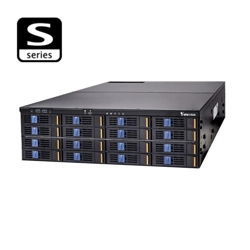Loading ...
Loading ...
Loading ...

VIVOTEK - A Leading Provider of Multimedia Communication Solutions
User's Manual - 51
RAID 1 Drive Groups
In RAID 1 drive groups, the RAID controller duplicates all data from one drive to a second drive
in the drive group. A RAID 1 drive group supports an even number of drives from 2 through 32
in a single span. The RAID1 drive group provides complete data redundancy, but at the cost
of doubling the required data storage capacity. The following table provides an overview of a
RAID1 drive group. The following gure provides a graphic example of a RAID1 drive group.
Uses Use RAID 1 drive groups for small databases or any other environment that requires fault
tolerance but small capacity.
Strong points Provides complete data redundancy.A RAID 1 drive group is ideal for any application that
requires fault tolerance and minimal capacity.
Weak points Requires twice as many drives.
Performance is impaired during drive rebuilds.
Drives 2 through 32 (must be an even number of drives)
Segment 1
RAID 1
Segment 1
Duplicate
Segment 5 Segment 5
Duplicate
...
Segment 2 Segment 2
Duplicate
Segment 6 Segment 6
Duplicate
...
Segment 3
Segment 3
Duplicate
Segment 7 Segment 7
Duplicate
...
Segment 4 Segment 4
Duplicate
Segment 8 Segment 8
Duplicate
...
RAID 1 RAID 1 RAID 1
RAID 5 Drive Groups
A RAID 5 drive group includes disk striping at the block level and parity. Parity is the data’s
property of being odd or even, and parity checking is used to detect errors in the data. In RAID5
drive groups, the parity information is written to all drives. A RAID5 drive group is best suited for
networks that perform a lot of small input/output (I/O) transactions simultaneously.The following
table provides an overview of a RAID5 drive group. The following gure provides a graphic
example of a RAID5 drive group.
Uses Provides high data throughput, especially for large les.
Use RAID 5 drive groups for transaction processing applications because each drive can
read and write independently.
If a drive fails, the RAID controller uses the parity drive to re-create all missing
information.Use also for online customer service that requires fault tolerance.Use for any
application that has high read request rates but random write request rates.
Strong points Provides data redundancy, high read rates, and good performance in most environments.
Provides redundancy with lowest loss of capacity.
Weak points Not well suited to tasks requiring lots of small writes or small block write operations.
Suers more impact if no cache is used.
Drive performance is reduced if a drive is being rebuilt.
Environments with few processes do not perform as well because the RAID drive group
overhead is not oset by the performance gains in handling simultaneous processes.
Drives 3 through 32
Loading ...
Loading ...
Loading ...
